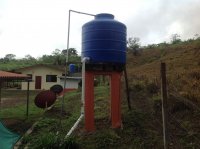Billy Grayson
New Member
We purchased property in Panama a few years back that has two buildings on it. One is a large main house and the other is a smaller "casita". Both buildings are supplied water by one well, each having its own holding tank. The system is currently manual, meaning that I have to switch the pump on to fill the tanks. I also have to turn a ball valve in order to divert water to one tank or the other. I did install Grundfos SBA pumps in each tank that have worked great for getting water from the tanks to the buildings.
On my next trip down, I plan on having a new well drilled (the current well is not deep enough and runs dry on a regular basis) and would like to automate the whole system. I know this is a multiple part question, but can someone explain in simple terms, the best way to supply water from the new well to these two buildings without having to manually divert it to each tank when the levels drop? As you can probably guess, my knowledge of well systems is poorly lacking, so I will greatly appreciate any help that's provided!
On my next trip down, I plan on having a new well drilled (the current well is not deep enough and runs dry on a regular basis) and would like to automate the whole system. I know this is a multiple part question, but can someone explain in simple terms, the best way to supply water from the new well to these two buildings without having to manually divert it to each tank when the levels drop? As you can probably guess, my knowledge of well systems is poorly lacking, so I will greatly appreciate any help that's provided!


![18920136_10213143746012308_4845528464570006286_n[1].jpg](/forums/data/attachments/61/61287-4b1b8f23fc42f96fd0424f13eb08f24e.jpg)